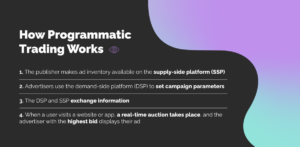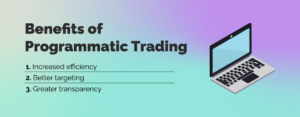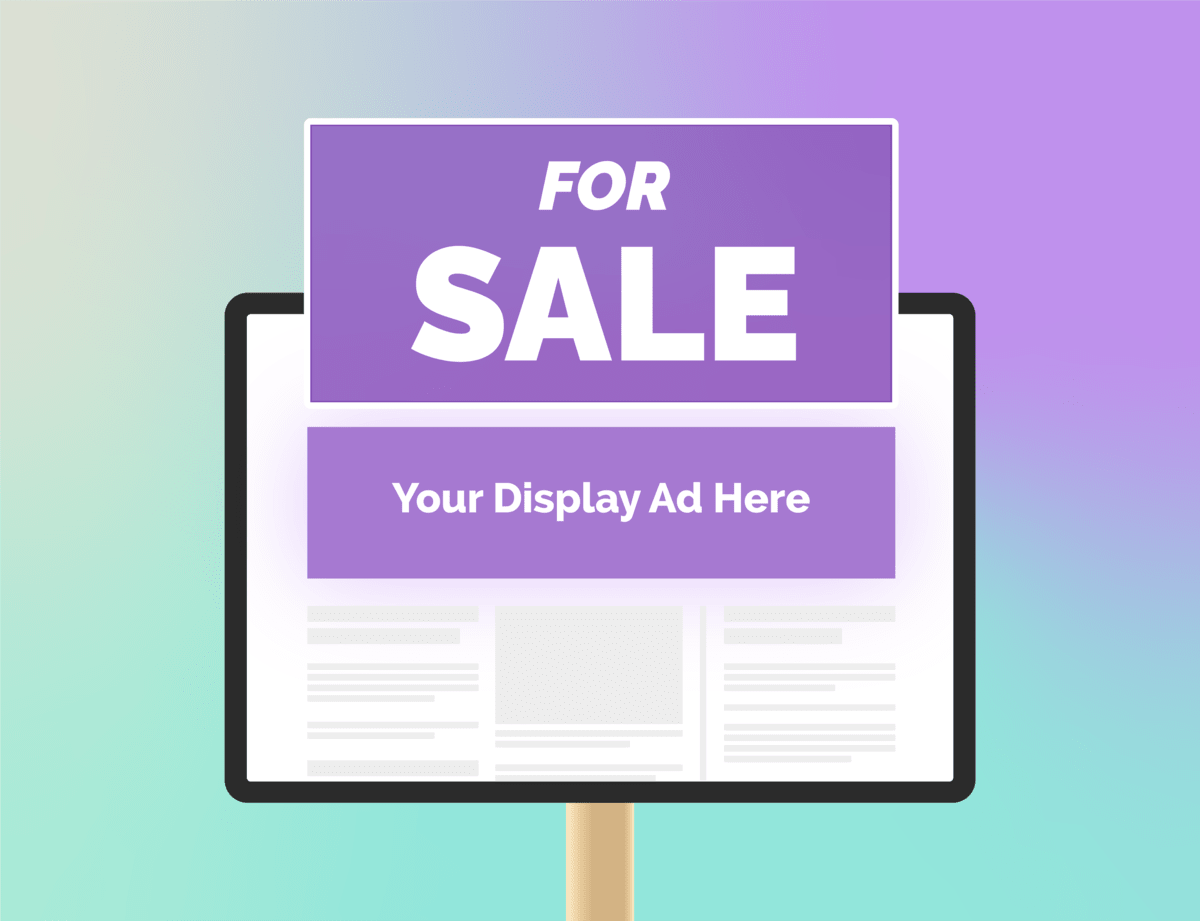Programmatic trading is the automated buying and selling of advertising inventory in real-time via an automated auction known as real-time bidding, or RTB.
Programmatic traders use machine learning and algorithms to match advertisers with publishers and their ad inventory. A programmatic trader is a programmatic advertising specialist who oversees the bidding process, using it to buy and sell digital media such as display ads and other types of digital advertising, such as video, audio, and native ads.
Programmatic traders have in-depth knowledge of the adtech ecosystem and help advertisers maximize their advertising budget in line with their business goals. In this article, we’ll walk you through the basics of programmatic trading.
Programmatic Trading Platforms
Let’s start with a quick refresh of the digital media trading platforms used for programmatic ad buying and selling.
- Demand-side platforms (DSPs): A DSP is a platform where advertisers can buy ad impressions from publishers. Publishers put their ad impressions for sale, and the DSP selects the right impressions for the advertiser through RTB.
- Supply-side platforms (SSPs): An SSP helps publishers sell their ad inventory programmatically — think of it as the publisher side of a DSP. SSPs are designed to maximize the prices of impressions for publishers.
- Ad exchanges: An ad exchange is a digital marketplace that connects advertisers and publishers to buy and sell inventory directly through real-time auctions.
How Programmatic Trading Works: The Fundamentals
The process of programmatic trading starts when a publisher — for example, a news site like the New York Times — makes their ad inventory available for purchase through an ad exchange or SSP, providing information about audiences, availability, and pricing.
Meanwhile, advertisers and agencies use DSPs to access and manage multiple ad exchanges and inventory sources. DSPs allow advertisers to set budget limits, campaign goals, and targeting criteria, which include parameters like demographics, browsing behavior, location, and interests.
Once these are set, the ad exchange connects the DSP to SSPs. The DSPs use this information to select the most relevant ad impressions for each advertiser, while the SSPs auction off the ad inventory to the highest bidder.
When a user visits a website or an app, the available ad space goes up for auction on an ad exchange. Advertisers using DSPs participate in a real-time bidding process where they submit their bids for the ad impressions they want to target.
The advertiser with the highest bid wins the auction, and their ad is displayed on the publisher’s website or app. This entire process happens in milliseconds, allowing ads to be displayed to the user in real-time.

What Does A Programmatic Trader Do?
Programmatic traders are programmatic ad campaign management specialists whose role is to effectively spend the allocated budget within RTB environments.
Their primary objective is to identify the most suitable inventory sources for advertisers, ensuring that campaign goals and return on ad spend (ROAS) targets are met.
Therefore, traders should have a deep understanding of the market where ad impressions occur so they can develop effective media buying strategies — such as retargeting and contextual targeting — to reach the desired audience, as well as strong analytical and problem-solving skills.
They also manage the technical aspects of launching ads to ensure compliance with ad placement restrictions and optimize campaign performance. This includes ensuring ads are only placed on reputable publishers’ websites and apps to protect the advertiser’s brand reputation.
Additionally, programmatic traders compile comprehensive reports by extracting and analyzing datasets. By providing information on ad performance, impressions, clicks, conversions, and other key metrics, these reports offer valuable insights into the drivers behind campaign performance, helping stakeholders understand the effectiveness of their advertising efforts. They also enable traders to continuously improve and optimize campaigns and make informed decisions about future ad buying.
Benefits of Programmatic Trading
If you’re still buying and selling ads the old-fashioned way through direct sales, your business may benefit from programmatic trading in the following ways:
- Increased efficiency: Programmatic trading allows you to buy ad space more quickly and easily than direct buying. With programmatic, you can buy ad space 24/7, which can improve efficiency and save you time and money.
- Better targeting: Programmatic trading allows you to target your ads to specific audiences based on user behavior and website context. This can help you reach targeted audiences with greater precision.
- Greater transparency: Programmatic trading provides you with more transparent insights into how your ads are being delivered and how much you are paying for each impression.

Harness the Power of Programmatic Trading
Programmatic trading is a powerful tool that can streamline and optimize your digital ad campaigns while boosting effectiveness and ROAS. However, leveraging programmatic trading to its full potential requires in-depth technical knowledge and expertise.
For this reason, many advertisers prefer to partner with programmatic trading experts — like the Grapeseed Media team — who specialize in planning, deploying, and managing advanced digital marketing campaigns. We have successfully run programmatic campaigns for numerous brands, such as the Grand Hyatt Hotel in New York, which achieved a 1,017% ROAS with our support.
Got questions about programmatic trading? Get in touch with our team or chat with Grape Bot, our proprietary chatbot specializing in all things programmatic.






